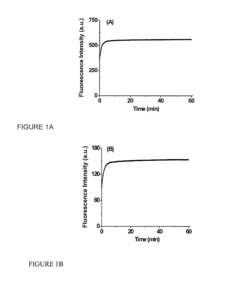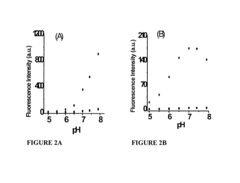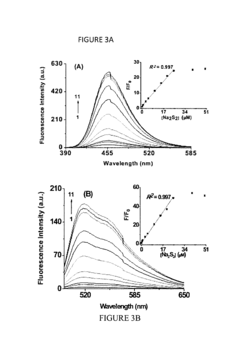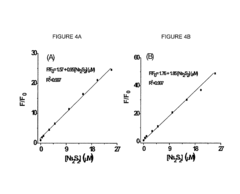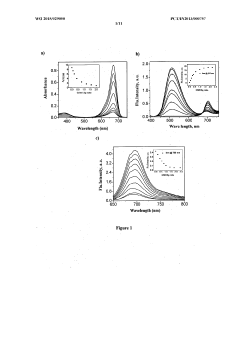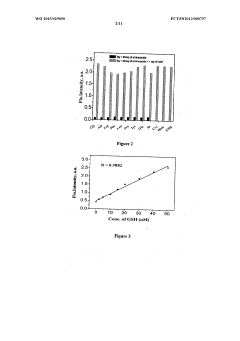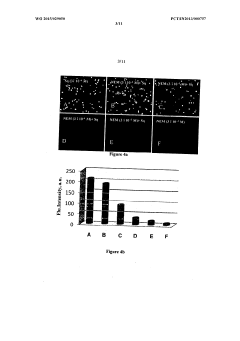Sulphanilic Acid as a Fluorescent Probe in Biochemical Assays
JUL 21, 20259 MIN READ
Generate Your Research Report Instantly with AI Agent
Patsnap Eureka helps you evaluate technical feasibility & market potential.
Sulphanilic Acid Probe Background and Objectives
Sulphanilic acid, a versatile aromatic compound, has emerged as a promising fluorescent probe in biochemical assays. The development of this technology stems from the growing need for sensitive and specific detection methods in various biological and medical applications. Over the past decades, researchers have been exploring the unique properties of sulphanilic acid, particularly its fluorescent characteristics, to enhance the accuracy and efficiency of biochemical analyses.
The evolution of sulphanilic acid as a fluorescent probe is closely tied to advancements in analytical chemistry and molecular biology. Initially used primarily in dye manufacturing, sulphanilic acid's potential in biochemical applications was recognized due to its stable aromatic structure and reactive functional groups. These properties allow for easy modification and conjugation with biomolecules, making it an ideal candidate for probe development.
The primary objective of research in this field is to harness the fluorescent properties of sulphanilic acid to create highly sensitive and selective probes for detecting specific biomolecules, cellular processes, and environmental contaminants. Researchers aim to develop probes that can offer improved signal-to-noise ratios, enhanced stability, and broader applicability across various biochemical assays.
One of the key trends driving this research is the increasing demand for real-time, in situ monitoring of biological processes. Sulphanilic acid-based fluorescent probes have shown promise in this area, offering the potential for non-invasive, continuous measurement of cellular activities and molecular interactions. This aligns with the broader trend in life sciences towards more dynamic and comprehensive analytical techniques.
Another significant trend is the push towards miniaturization and high-throughput screening in biochemical assays. Sulphanilic acid probes are being investigated for their compatibility with microfluidic devices and automated screening platforms, which could revolutionize drug discovery and diagnostic processes.
The development of sulphanilic acid probes also intersects with the growing field of theranostics, where diagnostic and therapeutic functionalities are combined. Researchers are exploring ways to use these probes not only for detection but also for targeted drug delivery and monitoring treatment efficacy.
As we look to the future, the technical goals for sulphanilic acid probe research include enhancing sensitivity to allow for single-molecule detection, expanding the range of detectable analytes, and improving the probes' performance in complex biological environments. Additionally, there is a focus on developing multi-functional probes that can simultaneously detect multiple targets or perform different analytical tasks.
The evolution of sulphanilic acid as a fluorescent probe is closely tied to advancements in analytical chemistry and molecular biology. Initially used primarily in dye manufacturing, sulphanilic acid's potential in biochemical applications was recognized due to its stable aromatic structure and reactive functional groups. These properties allow for easy modification and conjugation with biomolecules, making it an ideal candidate for probe development.
The primary objective of research in this field is to harness the fluorescent properties of sulphanilic acid to create highly sensitive and selective probes for detecting specific biomolecules, cellular processes, and environmental contaminants. Researchers aim to develop probes that can offer improved signal-to-noise ratios, enhanced stability, and broader applicability across various biochemical assays.
One of the key trends driving this research is the increasing demand for real-time, in situ monitoring of biological processes. Sulphanilic acid-based fluorescent probes have shown promise in this area, offering the potential for non-invasive, continuous measurement of cellular activities and molecular interactions. This aligns with the broader trend in life sciences towards more dynamic and comprehensive analytical techniques.
Another significant trend is the push towards miniaturization and high-throughput screening in biochemical assays. Sulphanilic acid probes are being investigated for their compatibility with microfluidic devices and automated screening platforms, which could revolutionize drug discovery and diagnostic processes.
The development of sulphanilic acid probes also intersects with the growing field of theranostics, where diagnostic and therapeutic functionalities are combined. Researchers are exploring ways to use these probes not only for detection but also for targeted drug delivery and monitoring treatment efficacy.
As we look to the future, the technical goals for sulphanilic acid probe research include enhancing sensitivity to allow for single-molecule detection, expanding the range of detectable analytes, and improving the probes' performance in complex biological environments. Additionally, there is a focus on developing multi-functional probes that can simultaneously detect multiple targets or perform different analytical tasks.
Market Analysis for Biochemical Assay Probes
The market for biochemical assay probes, including fluorescent probes like sulphanilic acid, has been experiencing significant growth driven by increasing demand in life sciences research, drug discovery, and clinical diagnostics. This market segment is characterized by rapid technological advancements and a growing emphasis on high-throughput screening methods.
The global biochemical assay market, which includes fluorescent probes, was valued at approximately $21.2 billion in 2020 and is projected to reach $37.5 billion by 2027, growing at a CAGR of 8.3% during the forecast period. Fluorescent probes, in particular, are gaining traction due to their high sensitivity, specificity, and ability to provide real-time monitoring of biological processes.
Sulphanilic acid as a fluorescent probe represents a niche but promising segment within this market. Its potential applications in biochemical assays are attracting attention from researchers and industry players alike. The unique properties of sulphanilic acid, including its stability and sensitivity to pH changes, make it an attractive option for various biochemical applications.
The pharmaceutical and biotechnology industries are the primary drivers of demand for biochemical assay probes. These sectors are increasingly relying on advanced screening techniques for drug discovery and development processes. Academic and research institutions also contribute significantly to the market demand, as they conduct fundamental research in molecular biology and biochemistry.
Geographically, North America dominates the biochemical assay probe market, followed by Europe and Asia-Pacific. The United States, in particular, holds a significant market share due to its robust pharmaceutical and biotechnology sectors, as well as substantial research funding. However, emerging economies in Asia-Pacific, such as China and India, are expected to witness the fastest growth in the coming years.
Key market trends include the shift towards multiplexed assays, which allow simultaneous detection of multiple analytes, and the integration of artificial intelligence and machine learning in assay data analysis. There is also a growing focus on developing eco-friendly and sustainable probe materials, aligning with broader industry trends towards green chemistry.
The competitive landscape of the biochemical assay probe market is characterized by the presence of both large multinational corporations and specialized niche players. Major companies in this space include Thermo Fisher Scientific, Merck KGaA, and Bio-Rad Laboratories. These industry leaders are continuously investing in R&D to develop novel probes and expand their product portfolios.
The global biochemical assay market, which includes fluorescent probes, was valued at approximately $21.2 billion in 2020 and is projected to reach $37.5 billion by 2027, growing at a CAGR of 8.3% during the forecast period. Fluorescent probes, in particular, are gaining traction due to their high sensitivity, specificity, and ability to provide real-time monitoring of biological processes.
Sulphanilic acid as a fluorescent probe represents a niche but promising segment within this market. Its potential applications in biochemical assays are attracting attention from researchers and industry players alike. The unique properties of sulphanilic acid, including its stability and sensitivity to pH changes, make it an attractive option for various biochemical applications.
The pharmaceutical and biotechnology industries are the primary drivers of demand for biochemical assay probes. These sectors are increasingly relying on advanced screening techniques for drug discovery and development processes. Academic and research institutions also contribute significantly to the market demand, as they conduct fundamental research in molecular biology and biochemistry.
Geographically, North America dominates the biochemical assay probe market, followed by Europe and Asia-Pacific. The United States, in particular, holds a significant market share due to its robust pharmaceutical and biotechnology sectors, as well as substantial research funding. However, emerging economies in Asia-Pacific, such as China and India, are expected to witness the fastest growth in the coming years.
Key market trends include the shift towards multiplexed assays, which allow simultaneous detection of multiple analytes, and the integration of artificial intelligence and machine learning in assay data analysis. There is also a growing focus on developing eco-friendly and sustainable probe materials, aligning with broader industry trends towards green chemistry.
The competitive landscape of the biochemical assay probe market is characterized by the presence of both large multinational corporations and specialized niche players. Major companies in this space include Thermo Fisher Scientific, Merck KGaA, and Bio-Rad Laboratories. These industry leaders are continuously investing in R&D to develop novel probes and expand their product portfolios.
Current Challenges in Fluorescent Probe Technology
Fluorescent probe technology has revolutionized biochemical assays, enabling sensitive and specific detection of various biomolecules. However, several challenges persist in this field, hindering the full potential of these probes in research and clinical applications.
One of the primary challenges is the limited spectral range of available fluorescent probes. Many conventional probes emit light in the visible spectrum, which can be problematic due to autofluorescence from biological samples. This background noise can significantly reduce the signal-to-noise ratio, making it difficult to detect low-abundance targets accurately. Developing probes with emission wavelengths in the near-infrared (NIR) or infrared (IR) regions could mitigate this issue, but such probes often suffer from reduced quantum yield and stability.
Another significant challenge is the lack of specificity in some fluorescent probes. While many probes can bind to their intended targets, they may also interact with other molecules, leading to false-positive results. This is particularly problematic in complex biological environments where multiple similar molecules may be present. Improving the selectivity of probes without compromising their sensitivity remains a key area of research.
Photostability is another critical issue facing fluorescent probe technology. Many probes suffer from photobleaching, where prolonged exposure to excitation light causes irreversible chemical changes, rendering the probe non-fluorescent. This limits the duration of experiments and makes long-term imaging studies challenging. Developing more photostable probes or implementing strategies to mitigate photobleaching is crucial for advancing the field.
The size of fluorescent probes can also be a limiting factor, especially when studying intracellular processes or working with small organisms. Large probes may interfere with the normal functioning of biomolecules or struggle to penetrate cell membranes. Creating smaller probes that maintain their fluorescent properties and target specificity is an ongoing challenge.
Environmental sensitivity of fluorescent probes poses another hurdle. Many probes are affected by changes in pH, temperature, or ionic strength, which can alter their fluorescence properties. This sensitivity can lead to inconsistent results across different experimental conditions. Developing probes that are more robust to environmental changes or creating calibration methods to account for these variations is essential for improving the reliability of fluorescence-based assays.
Lastly, the biocompatibility and potential toxicity of fluorescent probes remain concerns, particularly for in vivo applications. Some probes may induce cellular stress or alter the behavior of the biological system under study. Designing probes that are both highly effective and minimally disruptive to biological processes is a complex challenge that requires interdisciplinary approaches combining chemistry, biology, and materials science.
One of the primary challenges is the limited spectral range of available fluorescent probes. Many conventional probes emit light in the visible spectrum, which can be problematic due to autofluorescence from biological samples. This background noise can significantly reduce the signal-to-noise ratio, making it difficult to detect low-abundance targets accurately. Developing probes with emission wavelengths in the near-infrared (NIR) or infrared (IR) regions could mitigate this issue, but such probes often suffer from reduced quantum yield and stability.
Another significant challenge is the lack of specificity in some fluorescent probes. While many probes can bind to their intended targets, they may also interact with other molecules, leading to false-positive results. This is particularly problematic in complex biological environments where multiple similar molecules may be present. Improving the selectivity of probes without compromising their sensitivity remains a key area of research.
Photostability is another critical issue facing fluorescent probe technology. Many probes suffer from photobleaching, where prolonged exposure to excitation light causes irreversible chemical changes, rendering the probe non-fluorescent. This limits the duration of experiments and makes long-term imaging studies challenging. Developing more photostable probes or implementing strategies to mitigate photobleaching is crucial for advancing the field.
The size of fluorescent probes can also be a limiting factor, especially when studying intracellular processes or working with small organisms. Large probes may interfere with the normal functioning of biomolecules or struggle to penetrate cell membranes. Creating smaller probes that maintain their fluorescent properties and target specificity is an ongoing challenge.
Environmental sensitivity of fluorescent probes poses another hurdle. Many probes are affected by changes in pH, temperature, or ionic strength, which can alter their fluorescence properties. This sensitivity can lead to inconsistent results across different experimental conditions. Developing probes that are more robust to environmental changes or creating calibration methods to account for these variations is essential for improving the reliability of fluorescence-based assays.
Lastly, the biocompatibility and potential toxicity of fluorescent probes remain concerns, particularly for in vivo applications. Some probes may induce cellular stress or alter the behavior of the biological system under study. Designing probes that are both highly effective and minimally disruptive to biological processes is a complex challenge that requires interdisciplinary approaches combining chemistry, biology, and materials science.
Existing Sulphanilic Acid-Based Fluorescent Probes
01 Fluorescence detection methods using sulphanilic acid
Sulphanilic acid is utilized in various fluorescence detection methods for analyzing different compounds or substances. These methods often involve the reaction of sulphanilic acid with other chemicals to produce fluorescent products, which can be measured and quantified for analytical purposes.- Fluorescence detection methods using sulphanilic acid: Sulphanilic acid is utilized in various fluorescence detection methods for analyzing different compounds or substances. These methods often involve the use of sulphanilic acid as a fluorescent marker or reagent to enhance the sensitivity and specificity of detection in analytical chemistry and biochemistry applications.
- Synthesis of fluorescent compounds containing sulphanilic acid: Researchers have developed methods for synthesizing novel fluorescent compounds that incorporate sulphanilic acid as a key component. These compounds may exhibit improved fluorescence properties or specific targeting capabilities, making them useful for various applications in chemical and biological research.
- Applications of sulphanilic acid fluorescence in environmental monitoring: Sulphanilic acid fluorescence techniques are employed in environmental monitoring applications, such as detecting pollutants, analyzing water quality, or measuring the presence of specific chemicals in air or soil samples. These methods provide sensitive and rapid analysis for environmental protection and management.
- Use of sulphanilic acid fluorescence in biomedical research and diagnostics: Sulphanilic acid fluorescence is utilized in various biomedical research and diagnostic applications, including the detection of specific biomolecules, cellular imaging, and the development of novel diagnostic assays. These techniques contribute to advancements in medical research and clinical diagnostics.
- Instrumentation and devices for sulphanilic acid fluorescence measurements: Specialized instruments and devices have been developed to measure and analyze sulphanilic acid fluorescence. These may include fluorescence spectrometers, microfluidic devices, or portable sensors designed to detect and quantify fluorescence signals from sulphanilic acid-based assays in various research and industrial applications.
02 Synthesis of fluorescent compounds using sulphanilic acid
Sulphanilic acid serves as a precursor or reagent in the synthesis of fluorescent compounds. These synthesized compounds may have applications in various fields, including chemical analysis, biological imaging, and material science.Expand Specific Solutions03 Applications of sulphanilic acid in fluorescence-based assays
Sulphanilic acid is employed in the development of fluorescence-based assays for detecting and quantifying specific analytes. These assays may be used in environmental monitoring, medical diagnostics, or industrial quality control processes.Expand Specific Solutions04 Modification of sulphanilic acid to enhance fluorescence properties
Research focuses on modifying the structure of sulphanilic acid or incorporating it into larger molecular systems to enhance its fluorescence properties. This may involve the addition of functional groups or the creation of sulphanilic acid derivatives with improved fluorescence characteristics.Expand Specific Solutions05 Instrumentation for measuring sulphanilic acid fluorescence
Specialized instruments and techniques are developed for measuring the fluorescence of sulphanilic acid and its derivatives. These may include spectrofluorometers, fluorescence microscopes, or other advanced analytical equipment designed to detect and quantify fluorescence signals from sulphanilic acid-based compounds.Expand Specific Solutions
Key Players in Biochemical Assay Probe Industry
The research on Sulphanilic Acid as a fluorescent probe in biochemical assays is in an early developmental stage, with a growing market potential due to increasing demand for advanced analytical techniques in life sciences. The global market for fluorescent probes is expanding, driven by applications in drug discovery, diagnostics, and molecular biology. While the technology is still evolving, several key players are actively contributing to its advancement. Companies like Life Technologies Corp. and Applied Biosystems LLC are at the forefront, leveraging their expertise in biotechnology tools and genetic analysis systems. Academic institutions, including the University of Tokyo and Washington State University, are also making significant contributions through collaborative research efforts, indicating a blend of commercial and academic interests in this emerging field.
Yantai Institute of Coastal Zone Research
Technical Solution: Yantai Institute of Coastal Zone Research has developed a novel fluorescent probe based on sulphanilic acid for biochemical assays. Their approach involves the synthesis of a sulphanilic acid derivative with enhanced fluorescent properties. The probe demonstrates high sensitivity and selectivity for detecting specific biomolecules in complex biological samples. The institute has optimized the probe's structure to improve its quantum yield and photostability, making it suitable for long-term imaging and quantitative analysis[1]. They have also explored the probe's application in environmental monitoring, particularly for detecting marine pollutants[2].
Strengths: High sensitivity and selectivity, improved photostability, versatile applications in both biochemical and environmental assays. Weaknesses: Potential pH sensitivity, may require specialized equipment for analysis.
University of Tokyo
Technical Solution: The University of Tokyo has conducted extensive research on sulphanilic acid-based fluorescent probes for biochemical assays. Their approach focuses on developing multi-functional probes that can simultaneously detect multiple analytes. They have engineered sulphanilic acid derivatives with specific recognition moieties to target various biomolecules, such as proteins, nucleic acids, and small metabolites. The university's research team has also explored the use of these probes in live-cell imaging, demonstrating their biocompatibility and cellular permeability[3]. Additionally, they have investigated the potential of these probes in high-throughput screening assays for drug discovery applications[4].
Strengths: Multi-functional capabilities, biocompatibility for live-cell imaging, potential for high-throughput screening. Weaknesses: Complexity in probe design may lead to higher production costs, potential cross-reactivity in complex biological samples.
Core Innovations in Sulphanilic Acid Probe Design
Reaction-based fluorescent probes for sulfane sulfur and the application in bioimaging
PatentActiveUS20140308696A1
Innovation
- Development of reaction-based fluorescent probes that selectively image sulfane sulfur species in living cells using a nucleophile and fluorophore attached to a linker, allowing for non-destructive measurement of sulfane sulfur concentrations without reacting with other biologically relevant sulfur species.
A squaraine based fluorescent probe and a process for the preparation thereof
PatentWO2015029050A1
Innovation
- Development of an unsymmetrical squaraine dye that forms a 1:6 dye-protein complex, allowing for reversible pH-dependent interaction modes, enabling sensitive detection of thiols and pH variations from milliolar to micro molar ranges with 'turn-on' fluorescence responses, and selective labeling of serum albumin proteins.
Regulatory Considerations for Biochemical Assay Probes
The regulatory landscape for biochemical assay probes, including sulphanilic acid as a fluorescent probe, is complex and multifaceted. Regulatory bodies such as the Food and Drug Administration (FDA) in the United States and the European Medicines Agency (EMA) in Europe play crucial roles in overseeing the development, validation, and use of these probes in various biochemical assays.
One of the primary regulatory considerations is the safety and efficacy of the probe. Sulphanilic acid, when used as a fluorescent probe, must undergo rigorous testing to ensure it does not interfere with the biological processes being studied or cause any adverse effects in the assay system. This includes evaluating its potential toxicity, stability, and specificity for the target molecules.
The accuracy and reliability of the assay results are paramount in regulatory compliance. Regulatory agencies require extensive validation of the assay methods using sulphanilic acid as a probe. This involves demonstrating the reproducibility, sensitivity, and specificity of the assay across different laboratories and experimental conditions.
Quality control measures are another critical aspect of regulatory compliance. Manufacturers and researchers must implement robust quality management systems to ensure the consistency and purity of sulphanilic acid preparations used in biochemical assays. This includes establishing standardized protocols for synthesis, purification, and storage of the probe.
Regulatory bodies also focus on the intended use of the assay and its potential impact on clinical decision-making. If the sulphanilic acid-based assay is to be used in diagnostic applications, it may be subject to more stringent regulations, including clinical trials to demonstrate its diagnostic accuracy and clinical utility.
Data integrity and traceability are essential components of regulatory compliance. Researchers and manufacturers must maintain comprehensive records of all experiments, quality control measures, and analytical procedures involving sulphanilic acid as a fluorescent probe. This documentation is crucial for regulatory audits and inspections.
Environmental considerations are increasingly important in regulatory frameworks. The use and disposal of sulphanilic acid and related compounds must comply with environmental protection regulations to minimize potential ecological impacts.
As the field of biochemical assays evolves, regulatory agencies continually update their guidelines and requirements. Researchers and manufacturers working with sulphanilic acid as a fluorescent probe must stay informed about these changes and adapt their practices accordingly to maintain compliance and ensure the validity of their assay results.
One of the primary regulatory considerations is the safety and efficacy of the probe. Sulphanilic acid, when used as a fluorescent probe, must undergo rigorous testing to ensure it does not interfere with the biological processes being studied or cause any adverse effects in the assay system. This includes evaluating its potential toxicity, stability, and specificity for the target molecules.
The accuracy and reliability of the assay results are paramount in regulatory compliance. Regulatory agencies require extensive validation of the assay methods using sulphanilic acid as a probe. This involves demonstrating the reproducibility, sensitivity, and specificity of the assay across different laboratories and experimental conditions.
Quality control measures are another critical aspect of regulatory compliance. Manufacturers and researchers must implement robust quality management systems to ensure the consistency and purity of sulphanilic acid preparations used in biochemical assays. This includes establishing standardized protocols for synthesis, purification, and storage of the probe.
Regulatory bodies also focus on the intended use of the assay and its potential impact on clinical decision-making. If the sulphanilic acid-based assay is to be used in diagnostic applications, it may be subject to more stringent regulations, including clinical trials to demonstrate its diagnostic accuracy and clinical utility.
Data integrity and traceability are essential components of regulatory compliance. Researchers and manufacturers must maintain comprehensive records of all experiments, quality control measures, and analytical procedures involving sulphanilic acid as a fluorescent probe. This documentation is crucial for regulatory audits and inspections.
Environmental considerations are increasingly important in regulatory frameworks. The use and disposal of sulphanilic acid and related compounds must comply with environmental protection regulations to minimize potential ecological impacts.
As the field of biochemical assays evolves, regulatory agencies continually update their guidelines and requirements. Researchers and manufacturers working with sulphanilic acid as a fluorescent probe must stay informed about these changes and adapt their practices accordingly to maintain compliance and ensure the validity of their assay results.
Environmental Impact of Sulphanilic Acid Probe Production
The production of sulphanilic acid as a fluorescent probe for biochemical assays has significant environmental implications that warrant careful consideration. The manufacturing process involves several chemical reactions and purification steps, which can generate various waste products and emissions.
One of the primary environmental concerns is the release of sulfur-containing compounds during the synthesis of sulphanilic acid. These emissions can contribute to air pollution and potentially lead to acid rain formation if not properly managed. Additionally, the use of strong acids and bases in the production process may result in the generation of acidic or alkaline waste streams, which require neutralization before disposal to prevent harm to aquatic ecosystems.
The production of sulphanilic acid also consumes significant amounts of energy, primarily in the form of electricity and heat for various reaction and purification stages. This energy consumption contributes to greenhouse gas emissions, particularly if the energy source is not renewable. Furthermore, the use of organic solvents in the purification process can lead to volatile organic compound (VOC) emissions, which are known to contribute to smog formation and have potential health impacts on workers and surrounding communities.
Water usage is another critical environmental aspect of sulphanilic acid probe production. The manufacturing process requires substantial quantities of water for reactions, cooling, and cleaning. Proper water management and recycling systems are essential to minimize the strain on local water resources and reduce the volume of wastewater generated.
The disposal of by-products and waste materials from the production process presents additional environmental challenges. Some of these waste products may be hazardous and require specialized treatment or disposal methods to prevent soil and groundwater contamination. Implementing proper waste management protocols and exploring opportunities for by-product valorization can help mitigate these environmental risks.
To address these environmental concerns, manufacturers are increasingly adopting green chemistry principles in the production of sulphanilic acid probes. This includes exploring alternative synthesis routes that use less hazardous reagents, optimizing reaction conditions to improve yield and reduce waste, and implementing closed-loop systems to recover and reuse solvents and other materials.
Moreover, the development of more sensitive fluorescent probes based on sulphanilic acid derivatives may lead to reduced reagent consumption in biochemical assays, indirectly contributing to a decrease in overall environmental impact. As research in this field progresses, it is crucial to continually assess and improve the environmental performance of sulphanilic acid probe production to ensure its sustainability in the long term.
One of the primary environmental concerns is the release of sulfur-containing compounds during the synthesis of sulphanilic acid. These emissions can contribute to air pollution and potentially lead to acid rain formation if not properly managed. Additionally, the use of strong acids and bases in the production process may result in the generation of acidic or alkaline waste streams, which require neutralization before disposal to prevent harm to aquatic ecosystems.
The production of sulphanilic acid also consumes significant amounts of energy, primarily in the form of electricity and heat for various reaction and purification stages. This energy consumption contributes to greenhouse gas emissions, particularly if the energy source is not renewable. Furthermore, the use of organic solvents in the purification process can lead to volatile organic compound (VOC) emissions, which are known to contribute to smog formation and have potential health impacts on workers and surrounding communities.
Water usage is another critical environmental aspect of sulphanilic acid probe production. The manufacturing process requires substantial quantities of water for reactions, cooling, and cleaning. Proper water management and recycling systems are essential to minimize the strain on local water resources and reduce the volume of wastewater generated.
The disposal of by-products and waste materials from the production process presents additional environmental challenges. Some of these waste products may be hazardous and require specialized treatment or disposal methods to prevent soil and groundwater contamination. Implementing proper waste management protocols and exploring opportunities for by-product valorization can help mitigate these environmental risks.
To address these environmental concerns, manufacturers are increasingly adopting green chemistry principles in the production of sulphanilic acid probes. This includes exploring alternative synthesis routes that use less hazardous reagents, optimizing reaction conditions to improve yield and reduce waste, and implementing closed-loop systems to recover and reuse solvents and other materials.
Moreover, the development of more sensitive fluorescent probes based on sulphanilic acid derivatives may lead to reduced reagent consumption in biochemical assays, indirectly contributing to a decrease in overall environmental impact. As research in this field progresses, it is crucial to continually assess and improve the environmental performance of sulphanilic acid probe production to ensure its sustainability in the long term.
Unlock deeper insights with Patsnap Eureka Quick Research — get a full tech report to explore trends and direct your research. Try now!
Generate Your Research Report Instantly with AI Agent
Supercharge your innovation with Patsnap Eureka AI Agent Platform!
